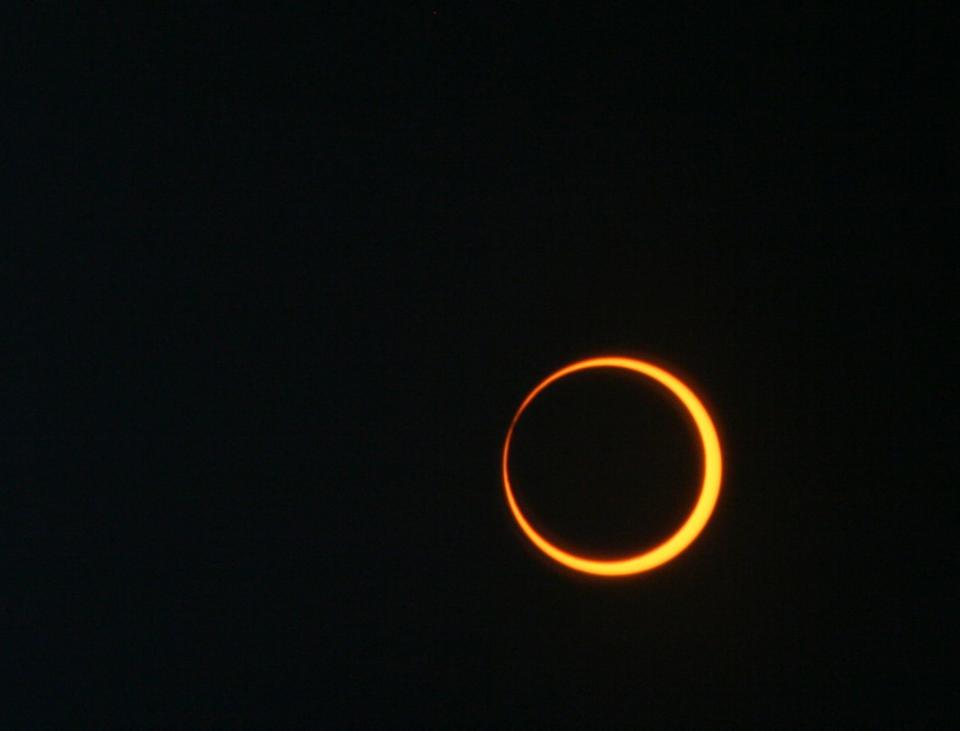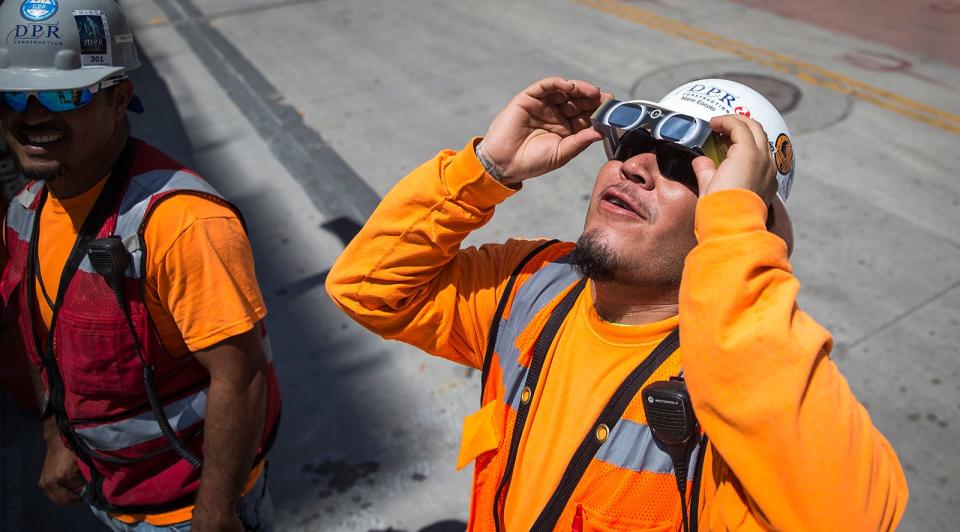How to watch the Oct. 14 'ring of fire' annular solar eclipse in Wisconsin
Itching to experience another astronomical event after August's blue super moon? Well, you're in luck.
An annular solar eclipse will be visible across portions of North and South America on Oct. 14. However, those looking up at the sky from Wisconsin won't be able to see its full "ring of fire" effect ― where the outer edge of the sun is visible around the moon.
What is an annular solar eclipse?
An annular solar eclipse happens when the moon passes between the Earth and the sun while at its farthest point from Earth. That means the moon won't completely block the sun. Instead, most of the sun is covered by the moon, but the uncovered part of the sun surrounding the perimeter of the moon appears as a very bright ring, or "annulus."
According to the National Oceanic and Atmospheric Administration, the upcoming eclipse will "create a path of darkness stretching from the Oregon coast to south Texas." While locations along this "path of annularity" are the best place to observe the eclipse, the eclipse will be partially visible across the entire U.S., including here in Wisconsin.

When is the annular solar eclipse?
The solar eclipse will occur on Saturday, Oct. 14. According to NASA, the eclipse will begin in Oregon around 9:13 a.m. PDT and end in Texas around 12:03 p.m. CDT.
Will you be able to see the eclipse in Wisconsin?
Yes. While the moon won't move entirely across the sun, you will be able see the moon cover anywhere from 36% to 47% of the sun, depending on where you are in the state. This is according to Eclipse2024, an interactive website where you can find out when and how well you can see the eclipse based on your city.
In Milwaukee, the eclipse will start at 10:37 a.m. CDT. The maximum coverage will be at 11:56 a.m., when the moon will cover 41% of the sun.
In Madison, the eclipse will start at 10:34 a.m. CDT. The maximum coverage will be at 11:54 a.m., when the moon will cover 44% of the sun.
Click on your city on Eclipse2024 to see a graphic representation of what the eclipse will look like where you are, as well as learn when it starts and when maximum coverage will occur.
For more interactive previews of the eclipse, check out this other simulator from Eclipse2024.org.
Which states will get the best view of the eclipse?
States along the path of annularity will get the most complete view of the eclipse. According to Eclipse2024, these are Arizona, California, Colorado, Nevada, New Mexico, Oregon, Texas and Utah.
The other U.S. states will be able to see a partial eclipse.
Do you need special glasses to view the partial solar eclipse?
According to NASA, because the sun is never fully blocked by the moon during an annular eclipse, it is never safe to look directly at sun without specialized eye protection while viewing the eclipse.
"Viewing any part of the bright Sun through a camera lens, binoculars, or a telescope without a special-purpose solar filter secured over the front of the optics will instantly cause severe eye injury," NASA says on its website.
NASA says that when watching the solar eclipse, you must look through safe solar viewing "eclipse glasses" or a safe, handheld solar viewer at all times.
"Eclipse glasses are NOT regular sunglasses; regular sunglasses, no matter how dark, are not safe for viewing the Sun. Safe solar viewers are thousands of times darker and ought to comply with the ISO 12312-2 international standard," NASA says.

Can you livestream the solar eclipse?
Yes, NASA will broadcast telescope views of the eclipse from across the U.S. on the official NASA YouTube channel.
The skywatching website timeanddate.com will also livestream the annular solar eclipse from start to finish with its livestream and live-blog with real-time progress reports and background information, according to the Sarasota Herald-Tribune.
When is the next solar eclipse?
The next annular solar eclipse that will be visible from the United States will take place on June 21, 2039. However, Alaska will be the only state in the path of the eclipse.
A total solar eclipse, the same type of eclipse as the August 2017 eclipse, will occur on April 8, 2024. During a total solar eclipse, the moon is at it's closest point to Earth, which allows it to block out the sun's light completely, rather than leaving a "ring" like an annular eclipse.
The April eclipse's path will go through Arkansas, Illinois, Indiana, Kentucky, Maine, Michigan, Missouri, New Hampshire, New York, Ohio, Oklahoma, Pennsylvania, Tennessee, Texas and Vermont, according to Eclipse2024. However, you'll be able to view the partial eclipse from states throughout the U.S.
Herald-Tribune reporter Cheryl McCloud contributed to this report.

SUPPORT LOCAL JOURNALISM: Our subscribers make this coverage possible. Subscribe to a USA TODAY NETWORK-Wisconsin site today with one of our special offers and support local journalism.
This article originally appeared on Milwaukee Journal Sentinel: Solar eclipse 2023: How to watch annular solar eclipse in Wisconsin

